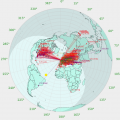G8JNJ
About
- Username
- G8JNJ
- Joined
- Visits
- 4,628
- Last Active
- Roles
- Member
- Points
- 127
Reactions
-
Advice on sharing RX antennas with 3 SDRs in the most effective way
Be careful regarding some of the commercial active splitters. Their IMD performance is not that good as they often use MMIC chips that can only achieve modest performance.
For example the Elad unit specifies an output IP3 of >24dBm, which is not particularly good, and would be typical of something using a PGA-103+ or similar as the active device which will provide an IMD performance of around an IOP2 of +50dBm and IOP3 of +30dBm.
My suggestion would be to use something like the DX Engineering RPA-1 followed by a Mini-Circuits splitter.
I've built a copy of the RPA-1 and it works well from about 10KHz to 40MHz and I have measured the IMD performance as an IOP2 of +92dBm and IOP3 of +45dBm.
Details are on my Active antennas web page.
https://www.g8jnj.net/activeantennas.htm
For GPS splitting you can use active L-Band splitters that were originally designed for distributing satellite TV services.
https://cpc.farnell.com/global-communications/split4af/4-way-active-splitter/dp/SE00009
I used this one but modified by cutting some tracks and adding an internal regulator so that it provided +5v out to feed the GPS antenna
Regards,
Martin - G8JNJ -
On-Line frequency database
Copied from UDXF@groups.io
"You may or may not be aware that the ITU monitoring stations publish their
listening logs on their public website:
https://www.itu.int/en/ITU-R/terrestrial/monitoring/Pages/Regular.aspx
This page describes the purpose of the monitoring activity as well as
allowing you to download the logs as Excel spreadsheets; there's also a
search tool so you can search for logs by frequency and date.
The spreadsheets often include DF bearings with an accuracy indication and
signal strength as well as time, frequency, mode, comments etc.
They often mention the kind of things we like listening to!"
I've previously taken a look at the ITU loggings but they always tended to be a bit of a pin to trawl through.
However the new database search tool is very good. Especially if you are careful about what search parameters you set. You can then click on a individual log entry for even more detail.
It would be even better if you could download the searched results, but maybe someone will get around to writing a scraper tool :-)
Regards,
Martin - G8JNJ -
On-Line frequency database
Copied from UDXF@groups.io
"You may or may not be aware that the ITU monitoring stations publish their
listening logs on their public website:
https://www.itu.int/en/ITU-R/terrestrial/monitoring/Pages/Regular.aspx
This page describes the purpose of the monitoring activity as well as
allowing you to download the logs as Excel spreadsheets; there's also a
search tool so you can search for logs by frequency and date.
The spreadsheets often include DF bearings with an accuracy indication and
signal strength as well as time, frequency, mode, comments etc.
They often mention the kind of things we like listening to!"
I've previously taken a look at the ITU loggings but they always tended to be a bit of a pin to trawl through.
However the new database search tool is very good. Especially if you are careful about what search parameters you set. You can then click on a individual log entry for even more detail.
It would be even better if you could download the searched results, but maybe someone will get around to writing a scraper tool :-)
Regards,
Martin - G8JNJ -
Ethernet filters
Hi All,
I see that DX Engineering are now offering Ethernet filters.
https://www.dxengineering.com/parts/dxe-iso-plus-2
"DX Engineering ISO-PLUS Ethernet RF Filters are very effective EMI Suppressors that are quickly and easily connected inline on Cat5e or Cat6 network cables. Their patent pending design provides common mode RF interference and EMI noise filtering of radio frequencies from well below 1 MHz to over 100 MHz. DX Engineering ISO-PLUS Ethernet RF Filters are bidirectional (input and output is interchangeable) and they have no effect on digital throughput; Ethernet data signal levels and speed remain unchanged."
Regards,
Martin - G8JNJ -
On-Line frequency database
Copied from UDXF@groups.io
"You may or may not be aware that the ITU monitoring stations publish their
listening logs on their public website:
https://www.itu.int/en/ITU-R/terrestrial/monitoring/Pages/Regular.aspx
This page describes the purpose of the monitoring activity as well as
allowing you to download the logs as Excel spreadsheets; there's also a
search tool so you can search for logs by frequency and date.
The spreadsheets often include DF bearings with an accuracy indication and
signal strength as well as time, frequency, mode, comments etc.
They often mention the kind of things we like listening to!"
I've previously taken a look at the ITU loggings but they always tended to be a bit of a pin to trawl through.
However the new database search tool is very good. Especially if you are careful about what search parameters you set. You can then click on a individual log entry for even more detail.
It would be even better if you could download the searched results, but maybe someone will get around to writing a scraper tool :-)
Regards,
Martin - G8JNJ -
Ethernet filters
Hi All,
I see that DX Engineering are now offering Ethernet filters.
https://www.dxengineering.com/parts/dxe-iso-plus-2
"DX Engineering ISO-PLUS Ethernet RF Filters are very effective EMI Suppressors that are quickly and easily connected inline on Cat5e or Cat6 network cables. Their patent pending design provides common mode RF interference and EMI noise filtering of radio frequencies from well below 1 MHz to over 100 MHz. DX Engineering ISO-PLUS Ethernet RF Filters are bidirectional (input and output is interchangeable) and they have no effect on digital throughput; Ethernet data signal levels and speed remain unchanged."
Regards,
Martin - G8JNJ -
Syllabic Voice Squelch
I found some notes on the subject of "New squelch algorithm for the WebSDR" on Pieter, PA3FWM's website - he uses this on his University of Twente WEB SDR
http://websdr.ewi.utwente.nl:8901/
http://www.pa3fwm.nl/technotes/tn16e.html
http://www.pa3fwm.nl/technotes/tn16f.html
Regards,
Martin - G8JNJ -
Possible TDoA problem when using KiWi's in 3 CH mode [fixed in v1.255]
This afternoon I tried using my second KiWi (in 3ch mode) running v1.250 to perform some TDoA runs.
The initial sampling completed OK, but when it tried to process the captures, after a while it came back with an "out of memory: use fewer Kiwis or check signal quality" error message.
Selecting the same TDoA but using my public KiWi running v1.249 in 4ch mode ran OK.
Changing my second KiWi running v1.250 back to 4ch mode and the TDoA ran OK.
Changing my second KiWi running v1.250 back to 3ch mode and I get the same error message.
I have previously used the KiWi in 8ch mode for TDoA and this ran OK, so I assume it's just a problem with the 3ch Mode.
Regards,
Martin - G8JNJ -
SAQ 17.2 kHz Christmas Eve Transmission
>
>has anyone attempted to use their PC soundcard microphone input connected to their antenna
>
Yes I have tried receiving several VLF stations using just a PC soundcard.
There is a some very simple receiver software, primarily designed for SAQ transmissions
https://sites.google.com/site/swljo30tb/home/files
But other more sophisticated applications such as spectrum lab have a preset VLF receiver mode.
https://www.qsl.net/dl4yhf/spectra1.html
Mains hum, ground loops and noise pickup from the PC data lines are the main issues when using a sound card.
I got the best results using an Icon Cube Pro USB soundcard 4ch with 196KHz sampling on a USB extender cable. But I find that unless you are really interested in extremely low level sub 10KHz signals the KiWi does a pretty good job.
Regards,
Martin - G8JNJ -
Wide band, vertically interleaved interference
Hi Alain,
I think it could be interference from a data over powerline adaptor. Take a look at the spectrum used by this device.
https://www.nikktech.com/main/articles/peripherals/network/powerline-adapters/6854-avm-fritz-powerline-1240e-wlan-set-review?showall=1&limitstart=
They are used to carry ethernet around the home over the mains power cabling. The interference often stops and starts when the ethernet link is being used. Unfortunately they radiate quite badly and can cause interference over a large area. Some manufacturers include notches on specific frequency bands and I think this is what you are seeing.
https://www.frequencycast.co.uk/powerline.html
Regards,
Martin - G8JNJ









